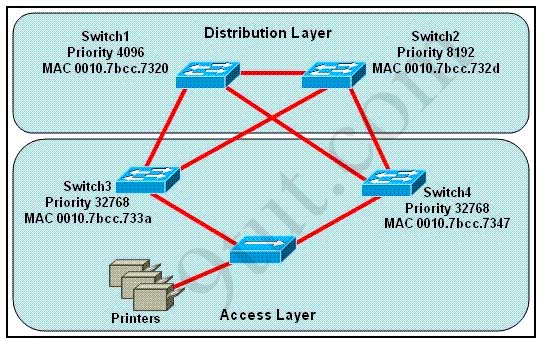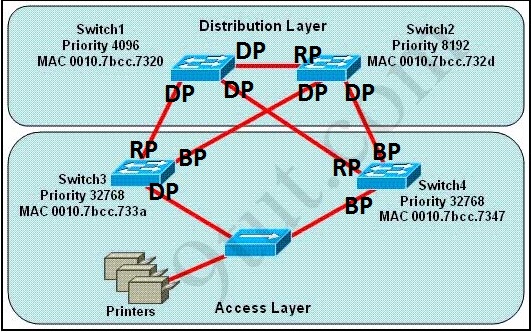ICND2 – STP Questions 2
[am4show have=’p2;’]
Premium Member: You can test your knowledge with these questions first via this link.
[/am4show]
Question 1
[am4show have=’p2;’]Which process is associated with spanning-tree convergence?
A. determining the path cost
B. electing designated ports
C. learning the sender bridge ID
D. assigning the port ID
Answer: B[/am4show]
Explanation
SPT must performs three steps to provide a loop-free network topology:
1. Elects one root bridge
2. Select one root port per nonroot bridge
3. Select one designated port on each network segment -> Answer B is correct.
Question 2
[am4show have=’p2;’]Which term describes a spanning-tree network that has all switch ports in either the blocking or forwarding state?
A. redundant
B. spanned
C. provisioned
D. converged
Answer: D[/am4show]
Explanation
Spanning Tree Protocol convergence (Layer 2 convergence) happens when bridges and switches have transitioned to either the forwarding or blocking state. When layer 2 is converged, root bridge is elected and all port roles (Root, Designated and Non-Designated) in all switches are selected.
Question 3
[am4show have=’p2;’]Refer to the exhibit. Which switch provides the spanning-tree designated port role for the network segment that services the printers?

A. Switch1
B. Switch2
C. Switch3
D. Switch4
Answer: C[/am4show]
Explanation
First, the question asks what switch services the printers, so it can be Switch 3 or Switch 4 which is connected directly to the Printers.
Next, by comparing the MAC address of Switch 3 and Switch 4 we found that the MAC of Switch 3 is smaller. Therefore the interface connected to the Printers of Switch 3 will become designated interface and the interface of Switch 4 will be blocked. The picture below shows the roles of all ports:

DP: Designated Port
RP: Root Port
BP: Blocked Port
(Please notice that Switch 1 will become the root bridge because of its lowest priority, not Switch 3)
Question 4
[am4show have=’p2;’]If primary and secondary root switches with priority 16384 both experience catastrophic losses, which tertiary switch can take over?
A. a switch with priority 20480
B. a switch with priority 8192
C. a switch with priority 4096
D. a switch with priority 12288
Answer: A[/am4show]
Explanation
This is a tricky question. We know the switch with lowest value of priority is elected the root switch. Therefore in this question the switches with priority of 4096, 8192, 12288 (which are lower than the current value of the root bridge 16384) are not joining the root bridge election by somehow. The only suitable answer is the switch with priority 20480 will become the root bridge.
Question 5
[am4show have=’p2;’]What kind of data message is send to elect the root bridge?
A. BPDU
B. Segment
C. Packets
D. Hello
Answer: A[/am4show]
Question 6
[am4show have=’p2;’]Which type does a port become when it receives the best BPDU on a bridge?
A. the backup port
B. the root port
C. the designated port
D. the alternate port
Answer: B[/am4show]
Question 7
[am4show have=’p2;’]Which value can you modify to configure a specific interface as the preferred forwarding interface?
A. the VLAN priority
B. the hello time
C. the port priority
D. the interface number
Answer: C[/am4show]
Question 8
[am4show have=’p2;’]Which VLAN bridge priority value is assigned by the set spantree root command?
A. 8192
B. 16384
C. 28672
D. 32768
Answer: A[/am4show]
Question 9
[am4show have=’p2;’]Which two statements about the spanning-tree bridge ID are true? (Choose two)
A. It is composed of a 4-bit bridge priority and a 12-bit system ID extension.
B. The bridge ID is transmitted in the IP header to elect the root bridge.
C. The system ID extension is a value between 1 and 4095.
D. It is composed of an 8-bit bridge priority and a 16-bit system ID extension.
E. The bridge priority must be incremented in blocks of 4096.
Answer: A E[/am4show]


Q13 imho is wrong, the only correct answer is E. The A is wrong cause it’s the Priority (2 bytes) part of the Bridge ID which is composed by a 4bit Bridge priority and a 12bit system ID extension
it seems q8 is wrong
when we set root primary, we get bridge id 24576
when we set root secondary, we get bridge id 28672
so 28672 is the right answer
question a can be confusing by the wording but read this it helped me https://www.cisco.com/c/en/us/support/docs/lan-switching/spanning-tree-protocol/5234-5.html
Hi – What is the answer to Q8?
Thanks
8192
https://www.cisco.com/c/en/us/support/docs/lan-switching/spanning-tree-protocol/5234-5.html
Q9 is correct AE
http://www.firewall.cx/networking-topics/protocols/spanning-tree-protocol/1054-spanning-tree-protocol-root-bridge-election.html
I think this is marked wrong or am I misreading?
Question 6
Which type does a port become when it receives the best BPDU on a bridge?
A. the backup port
B. the root port
C. the designated port
D. the alternate port
Answer: B
Shouldn’t it be C: designated port?
Q9
The Extended System ID is a value of 1 to 4095 corresponding to the respective VLAN participating in STP.
Certainly A and E are correct, but so is C.
The explanation for Q4 did not explain anything. So why aren’t the other switches (with lower BID) joining in the root bridge election?
Q4 never stated the lower priority switches actually exist. It states if priority 16384 are primary and secondary then answer A is the only possible answer and the others would already be the primary and secondary instead of the 16384 priority switches.
thought bridge id is priority plus MAC? forgive the sophomorism…
any ideas?
Still confused on Q8 – when you change the priority with the “spanning-tree vlan x root primary” command it lowers it to 24576 and secondary lowers it to 28672. I tried this on 3 different switches in my lab, the 3560G, 3750v2, and a really old 2950. It worked like this on all of them.
I read the cisco article that people posted, that command isn’t even a valid one on my switches with the latest IOS that is available.
I hope this question is retired, because its very confusing, and seems to be model specific….
I passed ICND2 on November 4th with 854! There are 54 questions, 4 drag and drop 2 labs for me EIGRP and GRE, BGP, ACL, IP SLA, RSTP, HSRP, PPPOE Questions! I have all the labs, and the majority of the questions, I have two courses and a lot of labs from CISCO and UDEMY to be prepare write alberthdr AT hotmail point com